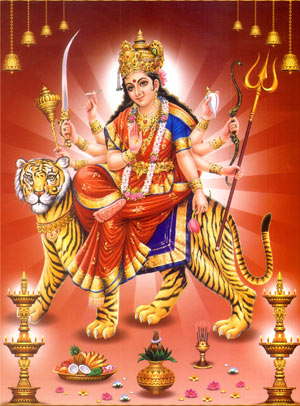Paid Services
Navratri 2017: Navratri Puja & Rituals
Author: Kavita Srivastava | Last Updated: Fri 17 Mar 2017 11:15:12 AM

Navratri is one of the most auspicious festivals of Hindus. As the name signifies ‘Nav’ means 'nine' and 'ratri' means 'night', 'Navratri' means 'nine nights'. Like every other Hindu festival Navratri as well has its legends. This festival holds special significance for Bengali and Gujarati as their level of fervor and enthusiasm is unmatched to any other state. Various festive activities are celebrated by them .Dandiya and Garba Rass are the highlights of the festival in Gujarat and Durga Puja in Kolkata. At places farmer s sow seeds and thank the Goddess for her blessings and pray for better yield. Every night of the Navratri is dedicated to Goddess Shakti and her various forms.
Each day of the Sharad Navratri is dedicated to an incarnation of Goddess Durga and they all are worshipped during Navratri. The first three days of Navratri are dedicated to Goddess Durga dressed in red and mounted on a lion. Her various incarnations namely Kumari, Parvati and Kali, are worshipped during Navratri. Each personification represents the three different states of womanhood that includes childhood, the young girl and the mature woman. Next three days are dedicated to Goddess Lakshmi who is regarded as the Goddess of Wealth and Prosperity as per Hindu mythology, dressed in gold and mounted on an owl. Last three are dedicated to Goddess Saraswati (Goddess of Knowledge) who is represented as dressed in milky white saree and mounted on a pure white swan. Devotees performs rigorous fast for nine days and sometimes for only on the first and the last day.
The festival culminates on Mahanavami. On this day, Kanya Puja is performed. Nine young girls representing the nine forms of Goddess Durga are worshiped. Their feet are washed as a mark of respect for the Goddess and then they are offered food and new clothes as gifts by the worshiper. This ritual is performed in most parts of the country. With commercialization, the festival has moved on to be a social festival rather than merely a religious one. However, nothing dampens the spirit of the devout followers of Goddess Durga, as they sing devotional songs and indulge in the celebrations of Navratri, year by year.
Navratri comes twice in a year, once around March-April and the second time, around September-October. Throughout this period of nine days there are certain religious norms that should be followed by every Hindu like observing fasts either for nine days or only for the first and the last day, strictly vegetarian diets, chanting mantras (in honor of the Goddess Shakti), religious hymns, prayer, meditation and recitation of sacred texts related to Mother Goddess form the order of the day. Apart from this, there are a number of other customs and rituals as well, which are associated with the festival are given below.
Customs & Rituals of Navratri
 Best quality gemstones with assurance of AstroCAMP.com More
Best quality gemstones with assurance of AstroCAMP.com More
 Take advantage of Yantra with assurance of AstroCAMP.com More
Take advantage of Yantra with assurance of AstroCAMP.com More
 Yantra to pacify planets and have a happy life .. get from AstroCAMP.com More
Yantra to pacify planets and have a happy life .. get from AstroCAMP.com More
 Best quality Rudraksh with assurance of AstroCAMP.com More
Best quality Rudraksh with assurance of AstroCAMP.com More
Get your personalised horoscope based on your sign.



















